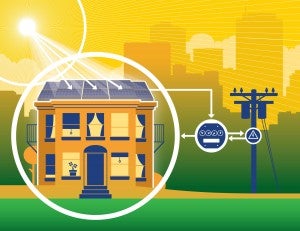Net Metering And Rooftop Solar For The Utility Of The Future
 Like the tide washing upon the shore, new technologies are gradually eroding electric utility revenues. These new products enable consumers to use cleaner energy and use it more efficiently. Electric utilities worry this trend will ravage their industry just as wireless technology convulsed the telecommunications industry. The utility industry urges its members to stem the tide by, among other things, increasing consumers’ net metering costs.
Like the tide washing upon the shore, new technologies are gradually eroding electric utility revenues. These new products enable consumers to use cleaner energy and use it more efficiently. Electric utilities worry this trend will ravage their industry just as wireless technology convulsed the telecommunications industry. The utility industry urges its members to stem the tide by, among other things, increasing consumers’ net metering costs.
Net metering makes small-scale renewable energy, such as rooftop solar panels, more affordable by crediting the “distributed generation” owners for the excess energy they produce. The electric meter measures how much electricity flows back to the grid from the distributed generation unit. A corresponding credit is applied to the consumer’s monthly energy bill. The Energy Policy Act of 2005 requires public utilities to offer net metering to all consumers upon request.
Why the new focus on net metering? The cost for rooftop solar panels has fallen 80% since 2008, including 20% in 2012 alone. Installed rooftop solar energy has increased by 900% between 2000 and 2011. As consumers install more rooftop solar panels and net meter them, utility revenues will decrease.
Net metering policies vary from state-to-state, including the amount of the payback for excess energy. The most favorable policy for distributed generation owners is an excess energy credit equal to the full retail energy rate consumers pay for energy, i.e. the amount consumers are charged for using energy. Most states use this measure. However, utilities claim this prevents them from recovering their full costs and overpays distributed generation owners, unfairly shifting costs to other consumers. Utilities say the credit should be equal to the utilities’ wholesale energy cost at the time of day when excess energy flows back to the grid.
Despite attempts by utilities to change net metering policies, state regulators are keeping these policies intact. Earlier this month, the Idaho Public Utilities Commission rejected Idaho Power’s request to pay less than the full retail rate and to impose higher charges on net metering consumers. Last month, the Louisiana Public Service Commission rejected similar requests by Louisiana utilities. More recently, Arizona Public Service Company raised the issue in a new filing.

As a general rule, paying the full retail rate is sound policy because rooftop solar capacity, or maximum electric output, only accounts for 0.2% of total capacity in the U.S. This will encourage consumers to install more renewable energy. Utilities will gain valuable experience on how distributed generation functions under local conditions, and how to integrate renewable energy into their electric grids.
The utility of the future, after distributed generation has achieved greater scale, will pay net metering customers for the full costs and benefits of the consumers’ renewable energy systems. A recent report lists the costs and benefits regulators should consider when setting net metering payments.[i] The costs include: inability to recover the utility’s existing costs under existing rate structures; interconnection costs; administrative and operational costs; and infrastructure costs to support distributed generation. The monetary benefits include: lower power delivery costs; lower power supply costs; lower system peak costs; and fuel flexibility benefits. The non-monetary benefits include: reduced toxic emissions and greenhouse gases; improved reliability; and local job creation.
After distributed generation reaches greater scale, this approach will accomplish several worthy objectives. Distributed generation developers and owners will receive the fair value for distributed generation. Distributed generation owners will be paid for the benefits provided by their units, which are currently overlooked. Utilities will have a better opportunity to recover their costs and remain financially viable. The utility’s cost of service will be fairly apportioned between consumers who own distributed generation and those who do not. With better information on distributed generation performance, new benefits will be recognized. These new benefits will increase the value of distributed generation and lower the cost of service for all utility consumers. This is how net metering and rooftop solar should function for the utility of the future.










